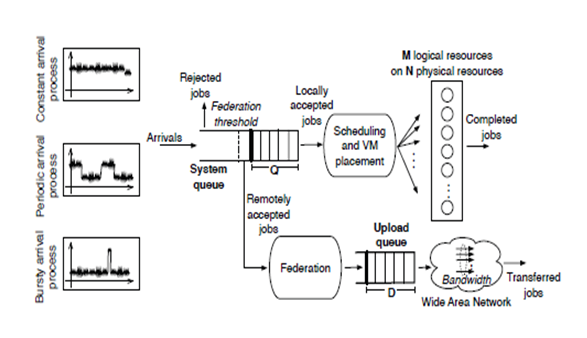A STOCHASTIC MODEL TO
INVESTIGATE DATA CENTER PERFORMANCE AND QOS IN IAAS CLOUD COMPUTING SYSTEMS
ABSTRACT:
Cloud data center management is a key problem due to
the numerous and heterogeneous strategies that can be applied, ranging from the
VM placement to the federation with other clouds. Performance evaluation of
Cloud Computing infrastructures is required to predict and quantify the
cost-benefit of a strategy portfolio and the corresponding Quality of Service
(QoS) experienced by users. Such analyses are not feasible by simulation or
on-the-field experimentation, due to the great number of parameters that have
to be investigated. In this paper, we present an analytical model, based on
Stochastic Reward Nets (SRNs), that is both scalable to model systems composed
of thousands of resources and flexible to represent different policies and
cloud-specific strategies. Several performance metrics are defined and
evaluated to analyze the behavior of a Cloud data center: utilization,
availability, waiting time, and responsiveness. A resiliency analysis is also
provided to take into account load bursts. Finally, a general approach is
presented that, starting from the concept of system capacity, can help system
managers to opportunely set the data center parameters under different working
conditions.
EXISTING
SYSTEM:
In order to integrate business requirements and
application level needs, in terms of Quality of Service (QoS), cloud service
provisioning is regulated by Service Level Agreements (SLAs): contracts between
clients and providers that express the price for a service, the QoS levels
required during the service provisioning, and the penalties associated with the
SLA violations. In such a context, performance evaluation plays a key role
allowing system managers to evaluate the effects of different resource
management strategies on the data center functioning and to predict the
corresponding costs/benefits.
Cloud
systems differ from traditional distributed systems. First of all, they are
characterized by a very large number of resources that can span different
administrative domains. Moreover, the high level of resource abstraction allows
to implement particular resource management techniques such as VM multiplexing
or VM live migration that, even if transparent to final users, have to be
considered in the design of performance models in order to accurately
understand the system behavior. Finally, different clouds, belonging to the
same or to different organizations, can dynamically join each other to achieve a
common goal, usually represented by the optimization of resources utilization.
This mechanism, referred to as cloud federation, allows to provide and
release resources on demand thus providing elastic capabilities to the whole
infrastructure.
DISADVANTAGES
OF EXISTING SYSTEM:
· On-the-field
experiments are mainly focused on the offered QoS, they are based on a black
box approach that makes difficult to correlate obtained data to the internal
resource management strategies implemented by the system provider.
· Simulation
does not allow to conduct comprehensive analyses of the system performance due
to the great number of parameters that have to be investigated.
PROPOSED
SYSTEM:
In this paper, we present a stochastic model, based
on Stochastic Reward Nets (SRNs), that exhibits the above mentioned features
allowing to capture the key concepts of an IaaS cloud system. The proposed
model is scalable enough to represent systems composed of thousands of
resources and it makes possible to represent both physical and virtual
resources exploiting cloud specific concepts such as the infrastructure
elasticity. With respect to the existing literature, the innovative aspect of
the present work is that a generic and comprehensive view of a cloud system is
presented. Low level details, such as VM multiplexing, are easily integrated
with cloud based actions such as federation, allowing to investigate different
mixed strategies. An exhaustive set of performance metrics are defined
regarding both the system provider (e.g., utilization) and the final users
(e.g., responsiveness).
ADVANTAGES
OF PROPOSED SYSTEM:
To provide a fair comparison among different
resource management strategies, also taking into account the system elasticity, a performance evaluation approach
is described. Such
an
approach, based on the concept of system capacity, presents a holistic view of
a cloud system and it allows system managers to study the better solution with
respect to an established goal and to opportunely set the system parameters.
SYSTEM
ARCHITECTURE:
SYSTEM CONFIGURATION:-
HARDWARE CONFIGURATION:-
ü Processor - Pentium –IV
ü Speed - 1.1
Ghz
ü RAM - 256
MB(min)
ü Hard
Disk - 20
GB
ü Key
Board - Standard
Windows Keyboard
ü Mouse -
Two or Three Button Mouse
ü Monitor - SVGA
SOFTWARE CONFIGURATION:-
ü Operating
System : Windows XP
ü Programming
Language : JAVA
ü Java
Version : JDK 1.6 &
above.
REFERENCE:
Dario
Bruneo, Member, IEEE-“ A
Stochastic Model to Investigate Data Center Performance and QoS in IaaS Cloud
Computing Systems”- IEEE TRANSACTIONS ON
PARALLEL AND DISTRIBUTED SYSTEMS 2013.

No comments:
Post a Comment